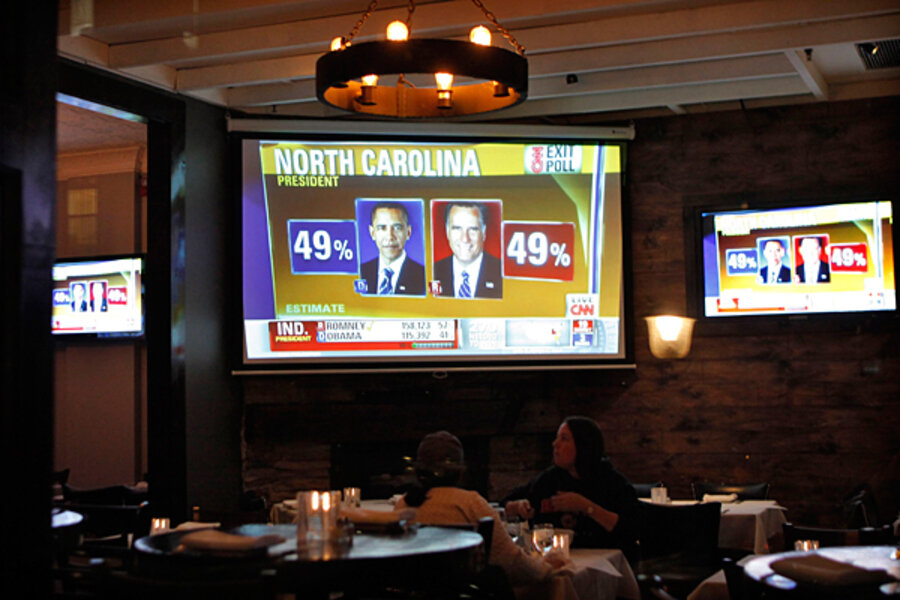On Election Night, score a victory for traditional media
Loading...
| Los Angeles
Social media may be the darling of a mobile generation weaned on interactivity and speed, but Election Night this year delivered a small silver lining of good news to so-called legacy media outlets such as newspapers and television.
With massive increases in traffic on news sites linked to such outlets as The New York Times and ABC News and with 66 million viewers watching TV, news of the legacy media’s death – to paraphrase Mark Twain – is greatly exaggerated.
“Content is still king,” says Len Shyles, communication professor at Villanova University in Philadelphia.
While many people now interact with social media such as Twitter and Facebook while they are watching TV, Professor Shyles says, “they are commenting on it, messing around with it, having fun with what they just heard, and sharing it with others.”
But, he points out, the legacy media is still the pre-eminent source, “and social media is still ancillary.”
Legacy media are stage setters for social media actors, agrees Charles Dunn, author of “The Seven Laws of Presidential leadership.”
Social media have come into their own as major players in political debate, he says via e-mail, “but legacy media continue to play the primary role in setting the stage for debate and discussion about political issues and personalities.”
Certainly the allocation of resources in the two campaigns leading up to Tuesday night supports this view.
According to the most recent report from the Wesleyan Media Project, the number of TV ads aired in the presidential general election passed the one million mark as of Oct. 29. The two candidates, their party committees, and supporting interest groups sponsored 1,015,615 ads since June 1, a 39.1 percent increase over 2008 and a 41 percent increase over 2004.
A recent student-conducted study from the Farmer School of Business at Miami University in Ohio also supports this media consumption model. When asked what media had the most influence on their knowledge of the issues in this election, 29 percent of student respondents said Fox News, 22 percent said social media such as Facebook and Twitter, and 12 percent said MSNBC.
The live element of Election Night gave a huge advantage to television, points out John Robinson, former editor of the News & Record newspaper in Greensboro, N.C., and adjunct journalism professor at the University of North Carolina in Chapel Hill.
“People get their quick updates on Twitter and Facebook, but they tune in to watch the events unfold live on television,” he says. “This is what the legacy networks already know from their sports events,” he adds, “where people will tweet and text during the event, but they stay tuned to watch it unfold in real time.”
And he says he watches as his students, using online searches, find and pass along content originating on sites belonging to major newspapers such as The Los Angeles Times and New York Times.
However, he points out, herein also lies the dark cloud growing around that silver lining.
“Many people, especially younger users, will tweet information and updates they found at the legacy media, but less and less do they either credit or even know the legacy media outlet that produced the information in the first place.”
This disconnect from the original source of information has serious consequences for outlets that rely on branding and advertising for their financial survival, Mr. Robinson says.
Perhaps equally important, while students in the Ohio study say they may glean more information from the more static, one-way model of traditional media, social media are more likely to move them to action.
“In terms of the youth vote in Ohio, clearly the Obama campaign’s effort surrounding social media paid off,” said William Even, professor of economics at the Farmer School of Business. “As our student survey revealed, social media is increasingly important in shaping political outcomes. While the majority of students continued to rely on traditional media for information on the presidential election, he adds, “social media seems to have had a larger effect on getting people to vote.”
The shift to more emphasis on social media will continue to grow because it appeals to our most basic desires to connect and engage, says Mike Gisondi of Socialbakers.com, which specializes in social media analytics.
Both candidates understood that their campaigns would be made or broken on the Internet and not on TV, he says via e-mail, “although that didn't stop the enormous media buys.” All Internet activity is essentially social, he says, because there is always a feedback mechanism, “be they likes, comments, shares, follow, etc. People feel a part of it. They're engaged, they interact, they feel they have a voice.”
Repetitive commercials are a one-way ticket to desensitizing and eventually disengaging a voter, he says.
Social media, on the other hand, deliver more connection. So while TV advertising in the US, for example, reaches 78 percent of the US on average, he says, and social media only 20 percent, “that 20 percent is more likely to be engaged.”







